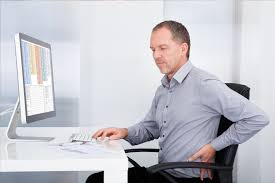
Standing the New Sitting
Smoke-free, sure, we all get that. Sugar-free, fat-free, gluten-free. But I’m talking about the new free you need to be. Not pet-free. You can keep Buster, and Lucky. I’m talking chair-free. There is a growing body of research that says that sitting in a chair is bad for your health; it can knock years off your life. Now before you go thinking that if you’ve got to go, getting knocked off by sitting may not be so bad, it’s actually increasing your risk of cardiovascular disease, cancer and type II diabetes. Standing is about to become the new sitting. The research is saying that even if you are a regular gym goer, you can’t make up for the hours spent sitting in the office chair. And as a physiotherapist at HealthMoves Physiotherapy in Edwardstown and Mawson Lakes, I also see sitting as a cause of back pain, as well as hip pain. Here I’ll explain why. We’ll then take a look at how you yourself stand, and show you how to stand well, which actually takes a bit of effort.
What’s Going On Down There
Sitting without using the chair back, which I generally do a lot of, means that you need to keep yourself upright using your hip flexor muscles, particularly iliopsoas and rectus femoris. You can become tight and short in these muscles, which then tip your pelvis forward when you stand. This puts extra load on your lumbar spine. Sitting right back in the chair may help to some extent, but those hip flexors are still active, and still in a shortened position. What if you also like to cross your legs? Now your hip abductors are getting stretched. With these long they will be less effective when you go for a walk, putting you at risk of increased extensor load on your low back, as well as excessive lumbar rotation and pelvic asymmetry. It can also lead to a loss of the fine muscle control that your hip joint needs. You may not notice anything on a day-to-day basis, but over time that hip, and your back, can become painful and stiff. There are exercises that you can do to retrain muscles and movements to overcome this. Your physiotherapist can show you these. But preferably don’t let the problem start in the first place. That means you have to get out of the chair.
Standing Can Take Work
Standing; you did it before you could walk, yet it can be quite hard to do well. Often we stand with our pelvis too tipped forward. This can be due to those tight hip flexors (from sitting), and because the muscle that counteracts them, our large abdominal muscle, the rectus abdominis, has become long, adapting to our posture, our big bellies, and general poor muscle use. Want to see how you stack up? Try this. Stand up. Put one hand on your hips, like you do when you are impersonating the tea pot. Your middle finger will probably be resting on that prominent bone at the front of your pelvis, that’s your anterior superior iliac spine (ASIS). Now put your other hand on your symphysis pubis. Best not be out in public when you do this. It’s that bone in the front down your middle, just above your special bits. Which hand is further forward? Your tea-pot hand on your ASIS? Then like many of us you stand with your pelvis tipped forward. For a neutral spine position you need to tip your pelvis to bring both those points into the same vertical plane, line them up. That means sucking your tummy in, contracting your rectus abdominis, so you tilt your pelvis back to bring those points in to line. You may find that your buttock muscles contract as you do this, that’s okay. But don’t squeeze your legs out too hard, I don’t want you to lock your knees out. This is also the position that your spine should be in when you walk. Go get Buster, try it out.
Physiotherapist
Health Moves Physiotherapy, Edwardstown and Mawson Lakes.



